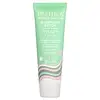What's inside
What's inside
 Key Ingredients
Key Ingredients

 Benefits
Benefits

 Concerns
Concerns

 Ingredients Side-by-side
Ingredients Side-by-side

Water
Skin ConditioningCetearyl Alcohol
EmollientDecyl Glucoside
CleansingVitis Vinifera Seed Oil
EmollientBambusa Arundinacea Stem Powder
AbrasiveCetearyl Olivate
Glycerin
HumectantPersea Gratissima Oil
Skin ConditioningSorbitan Olivate
EmulsifyingVaccinium Myrtillus Fruit Extract
Skin ConditioningGluconolactone
Skin ConditioningCalophyllum Tacamahaca Seed Oil
EmollientPanthenol
Skin ConditioningSaccharum Officinarum Extract
MoisturisingCitrus Aurantium Dulcis Fruit Extract
MaskingCitrus Limon Fruit Extract
MaskingAcer Saccharum Sap Extract
HumectantCurcuma Longa Root Oil
PerfumingCananga Odorata Flower Oil
MaskingCitrus Aurantium Dulcis Peel Oil
MaskingHelianthus Annuus Seed Oil
EmollientCitrus Grandis Seed Extract
AstringentTocopherol
AntioxidantXanthan Gum
EmulsifyingSodium Citrate
BufferingSodium Benzoate
MaskingCalcium Gluconate
HumectantWater, Cetearyl Alcohol, Decyl Glucoside, Vitis Vinifera Seed Oil, Bambusa Arundinacea Stem Powder, Cetearyl Olivate, Glycerin, Persea Gratissima Oil, Sorbitan Olivate, Vaccinium Myrtillus Fruit Extract, Gluconolactone, Calophyllum Tacamahaca Seed Oil, Panthenol, Saccharum Officinarum Extract, Citrus Aurantium Dulcis Fruit Extract, Citrus Limon Fruit Extract, Acer Saccharum Sap Extract, Curcuma Longa Root Oil, Cananga Odorata Flower Oil, Citrus Aurantium Dulcis Peel Oil, Helianthus Annuus Seed Oil, Citrus Grandis Seed Extract, Tocopherol, Xanthan Gum, Sodium Citrate, Sodium Benzoate, Calcium Gluconate
Sea Salt
AbrasiveCocamidopropyl Hydroxysultaine
CleansingGlycerin
HumectantSucrose
HumectantGlyceryl Caprylate/Caprate
EmollientSodium Methyl Cocoyl Taurate
CleansingSodium Cocoyl Isethionate
CleansingJojoba Esters
EmollientCharcoal Powder
AbrasiveRosmarinus Officinalis Leaf Extract
AntimicrobialLavandula Angustifolia Flower Extract
CleansingRosa Moschata Seed Oil
EmollientMentha Piperita Oil
MaskingMenthol
MaskingMelaleuca Alternifolia Leaf Oil
AntioxidantGlyceryl Stearate Se
EmulsifyingLactococcus Ferment Lysate
Skin ConditioningOryza Sativa Bran Extract
Skin ConditioningHelianthus Annuus Extract
EmollientTocopherol
AntioxidantSodium Benzoate
MaskingPotassium Sorbate
PreservativeSodium Gluconate
Skin ConditioningIron Oxides
Citric Acid
BufferingParfum
MaskingSea Salt, Cocamidopropyl Hydroxysultaine, Glycerin, Sucrose, Glyceryl Caprylate/Caprate, Sodium Methyl Cocoyl Taurate, Sodium Cocoyl Isethionate, Jojoba Esters, Charcoal Powder, Rosmarinus Officinalis Leaf Extract, Lavandula Angustifolia Flower Extract, Rosa Moschata Seed Oil, Mentha Piperita Oil, Menthol, Melaleuca Alternifolia Leaf Oil, Glyceryl Stearate Se, Lactococcus Ferment Lysate, Oryza Sativa Bran Extract, Helianthus Annuus Extract, Tocopherol, Sodium Benzoate, Potassium Sorbate, Sodium Gluconate, Iron Oxides, Citric Acid, Parfum
Alternatives
Ingredients Explained
These ingredients are found in both products.
Ingredients higher up in an ingredient list are typically present in a larger amount.
Glycerin is already naturally found in your skin. It helps moisturize and protect your skin.
A study from 2016 found glycerin to be more effective as a humectant than AHAs and hyaluronic acid.
As a humectant, it helps the skin stay hydrated by pulling moisture to your skin. The low molecular weight of glycerin allows it to pull moisture into the deeper layers of your skin.
Hydrated skin improves your skin barrier; Your skin barrier helps protect against irritants and bacteria.
Glycerin has also been found to have antimicrobial and antiviral properties. Due to these properties, glycerin is often used in wound and burn treatments.
In cosmetics, glycerin is usually derived from plants such as soybean or palm. However, it can also be sourced from animals, such as tallow or animal fat.
This ingredient is organic, colorless, odorless, and non-toxic.
Glycerin is the name for this ingredient in American English. British English uses Glycerol/Glycerine.
Learn more about GlycerinSodium Benzoate is a preservative. It's used in both cosmetic and food products to inhibit the growth of mold and bacteria. It is typically produced synthetically.
Both the US FDA and EU Health Committee have approved the use of sodium benzoate. In the US, levels of 0.1% (of the total product) are allowed.
Sodium benzoate works as a preservative by inhibiting the growth of bacteria inside of cells. It prevents the cell from fermenting a type of sugar using an enzyme called phosphofructokinase.
It is the salt of benzoic acid. Foods containing sodium benzoate include soda, salad dressings, condiments, fruit juices, wines, and snack foods.
Studies for using ascorbic acid and sodium benzoate in cosmetics are lacking, especially in skincare routines with multiple steps.
We always recommend speaking with a professional, such as a dermatologist, if you have any concerns.
Learn more about Sodium BenzoateTocopherol (also known as Vitamin E) is a common antioxidant used to help protect the skin from free-radicals and strengthen the skin barrier. It's also fat soluble - this means our skin is great at absorbing it.
Vitamin E also helps keep your natural skin lipids healthy. Your lipid skin barrier naturally consists of lipids, ceramides, and fatty acids. Vitamin E offers extra protection for your skin’s lipid barrier, keeping your skin healthy and nourished.
Another benefit is a bit of UV protection. Vitamin E helps reduce the damage caused by UVB rays. (It should not replace your sunscreen). Combining it with Vitamin C can decrease sunburned cells and hyperpigmentation after UV exposure.
You might have noticed Vitamin E + C often paired together. This is because it is great at stabilizing Vitamin C. Using the two together helps increase the effectiveness of both ingredients.
There are often claims that Vitamin E can reduce/prevent scarring, but these claims haven't been confirmed by scientific research.
Learn more about Tocopherol